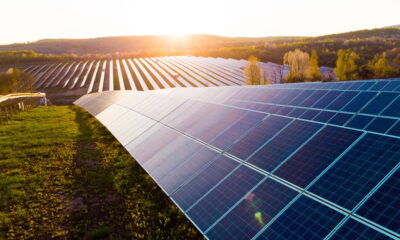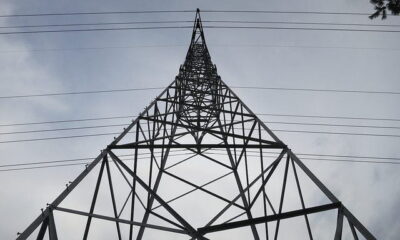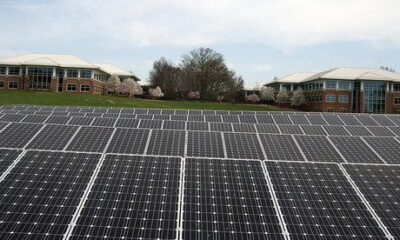

Energy
Exclusive: ‘Making and Saving Money with Solar’ by Michael Boxwell
Greenstream Publishing has published the tenth edition of the best-selling title the Solar Electricity Handbook. Blue & Green Tomorrow has been given exclusive access to an article adapted from the handbook written by industry expert and author, Michael Boxwell.
Creating energy with solar is not only environmentally friendly, it can also be good for your bank account too. Whether you are considering solar as a way of offsetting your electricity bill in your home or business, or if you are considering a solar installation to avoid the high cost of connection to the electricity grid, solar can often save you money.
In addition, there are often subsidies, grants or other financial incentives available to make solar a more attractive purchase. In some cases, these incentives alone are sufficient to pay for your solar installation over a period of a few years.
Installing electricity to a new building
If you are looking to install an electricity connection to a new building, installing your own solar power station can often be cheaper than installing the power lines. This is particularly true if you live in a rural location where power lines may not run close to the building. Even simple connections to a roadside property can easily cost several thousand, and if your property is suitable for solar power, it can quite easily become more cost effective to go completely ‘off grid’ and create all of your own power from solar.
Of course, there are limitations to this approach. You have to produce all the energy that you use, and you will need a watchful eye on your electricity usage to make sure you do not run out. Yet this can be a practical option for many locations where a conventional electricity connection is otherwise unaffordable.
Subsidies, grants and other financial incentives
Solar has traditionally been a more expensive source of electricity production when compared with traditional power sources. Prices have fallen significantly over the past few years but it is still the case that for many installations, solar does cost more than other power options.
Various countries offer financial incentives for people to invest in solar, either through grant schemes that help pay some of the cost for installing solar, or more commonly, through a feed in tariff, renewable energy certificates, export tariffs, net metering or a combination of all four.
As solar prices continue to fall, these subsidies are being reduced. Some countries have already reduced their schemes to nominal levels and it is widely expected that virtually all subsidies will be withdrawn by the end of the decade. However, the recent COP21 World Climate Summit held in Paris during December 2015 brought environmentally friendly power generation sharply back into focus. Many governments are now reviewing their incentives for encouraging the uptake of solar and this is likely to prolong or extend some of the schemes for longer than previously anticipated.
Grant Schemes, Low Interest Loans and Tax Rebates
Grant schemes, low interest loans and tax rebates are paid for directly out of government funds. Consequently, they can be unpopular with some politicians and the wider electorate, who often resent tax-payers money being used as a green energy subsidy.
Grants for installing solar are now becoming much rarer, although a few schemes are still available around the world for specific applications. In the United Kingdom, for example, there is a Rural Development Programme that has a fund to help farmers, land owners and community co-operatives. This fund consists of a grant of up to £20,000 to test the viability of a renewable energy system, followed by a low-interest, unsecured loan to fund up to 50% of the installation costs for a wind, solar or hydro-power project.
In several States of the United States, including California, there are tax rebates for solar energy, whether these are installed for residential, commercial or agricultural purposes. There are also rebates for solar installations for low-income families and for multi-family affordable housing projects. The exact detail of these schemes does vary between counties and states.
These are just two examples of the schemes that are available. There are other examples and if you are considering installing a solar energy system, it is worth investigating whether there are any grant schemes or tax rebates that may help you fund part of the cost.
Feed In Tariffs
A feed in tariff encourages home owners, business owners, communities and private investors to generate their own renewable energy and receive financial compensation for this energy. The feed in tariff has been one of the principle reasons why residential solar has become so immensely popular in many parts of the United States and Europe over the past six years.
Feed in tariffs typically work by providing a payment for every kilowatt-hour of electricity generated by a solar energy system. The payment is made whether the electricity is used by the owner of the system, or if it is exported. The tariff is typically guaranteed for around twenty years and most schemes incorporate index-linked price increases to ensure the value of the income from the tariff matches inflation.
Feed in tariffs are usually administered and paid for by the energy companies rather than by government. In the United Kingdom, for example, all consumers pay a green energy levy on their energy bills. This levy is then used to pay for various green initiatives, including paying the feed in tariff. Solar owners are paid the feed in tariff every three months, either receiving it as a discount from their energy bills or by having the money paid directly into a bank account.
Some feed in tariff schemes only relate to grid-tied systems, whereas other schemes offer feed in tariffs for both grid-tie and stand-alone systems.
Export Tariffs
An export tariff provides a set rate for selling electricity back to the energy companies. In some schemes the export tariff is set at an inflated rate in order to help solar owners recoup their investment more quickly. In other schemes, the export tariff is set at the commercial rate for electricity production.
Some countries set the export tariff at a fixed level over a ten, fifteen or twenty year period, incorporating index-linked price increases. Other countries allow the export tariff to rise or fall in line with the wholesale electricity prices.
Net Metering
Net metering schemes monitor the amount of energy used by the site and the amount of energy produced by the solar energy system. The energy company buys the electricity produced by the solar energy system at the same rate as they sell electricity back to the site owner.
Renewable Energy Certificates
Renewable Energy Certificates are a way of encouraging existing energy companies to invest in renewable energy themselves, or to source renewable energy from other suppliers. In most countries, they are only available for larger renewable energy installations, starting at 10kW in the United States and 50kW in the United Kingdom. They are not applicable for home installations except in Australia.
In this scheme, renewable energy providers are issued Renewable Energy Certificates for each megawatt-hour of electricity produced from green sources (1MWh = 1,000kWh). Energy companies are set targets for the amount of renewable energy they provide as a percentage of overall energy production. Energy companies then have to prove they have produced sufficient renewable energy themselves, by providing copies of their Renewable Energy Certificates, or they must buy Renewable Energy Certificates from other providers in order to demonstrate that they have reached their targets. Failure to provide sufficient certificates results in a substantial fine.
Renewable Energy Certificates trade on the open market. Values can fluctuate, but typically double the income from simply selling the electricity at the current wholesale rate.
Renewable Energy Certificates are known by different names in different countries. In the United Kingdom, they are known as Renewable Obligation Certificates (ROCs), in the United States they are referred to as Renewable Energy Credits (RECs) or Solar Renewable Energy Credits (SRECs), whilst in Australia they are referred to as Solar Credits or STCs.
In Conclusion
- Installing solar energy is not just good for the environment. In many cases it can make sound financial sense.
- Energy prices are increasing far faster than the general rate of inflation.
- Many countries have financial incentives to help fund solar installations, either helping with up-front capital costs, or more often by providing an ongoing income to help cover the costs of installation over the lifetime of the system.
Financial Incentives in different countries (sidebar)
Financial incentives for installing solar are constantly under review, reflecting both the reducing cost of solar and the popularity of solar installations. As well as country or region-wide incentives, there are often specific incentives for different industries, particularly in the agriculture, new build and social housing sectors. It is always worth spending some time searching online to find out what incentives may be available to you.
These websites provide up-to-date details for financial incentives for different countries:


 Environment9 months ago
Environment9 months agoAre Polymer Banknotes: an Eco-Friendly Trend or a Groundswell?

 Environment10 months ago
Environment10 months agoEco-Friendly Home Improvements: Top 7 Upgrades for 2025

 Energy12 months ago
Energy12 months agoA Closer Look at The Rapid Growth of Solar Energy in Ireland

 Features8 months ago
Features8 months agoEco-Friendly Cryptocurrencies: Sustainable Investment Choices





























